Scoliosis mostly affects children and adolescents. It is a medical condition that pertains to a sideways curving of one's spine, resembling an "S" or "C" shape, as opposed to being straight. This condition can make normal, day-to-day movements hard to carry out, as well as causes a difficulty in breathing as the lungs cannot operate properly due to limited chest space, caused by the condition. This article will detail exercises for scoliosis that you can try to ease the condition.
Before the Exercise: Consult Your Doctor
Before you begin self-correction exercises designed for scoliosis, it is important that you first speak with your doctor. Some exercises may be very helpful, whereas others may have disastrous consequences. Speaking with your doctor first about the types of exercise you wish to try will ensure that you do not perform any harmful actions that may exacerbate and worsen your condition.
Best Exercises for Scoliosis Self-Correction
1. Side Stretch with Exercise Ball
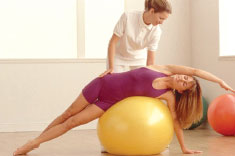
- You can also do some exercises for scoliosis with an exercise ball. Start with kneeling on an exercise mat then place your spine's convex side against the ball on a point between the hip and rib cage.
- Lean sideways towards and over the ball until you are resting your side against the ball, which should sit between your hips and the bottom of your rib cage.
- Gain your balance and stretch your hand outward on the opposing side.Hold for around 20-30 seconds, doing 2-3 reps for each day.
2. Towel Foam Roller Stretch
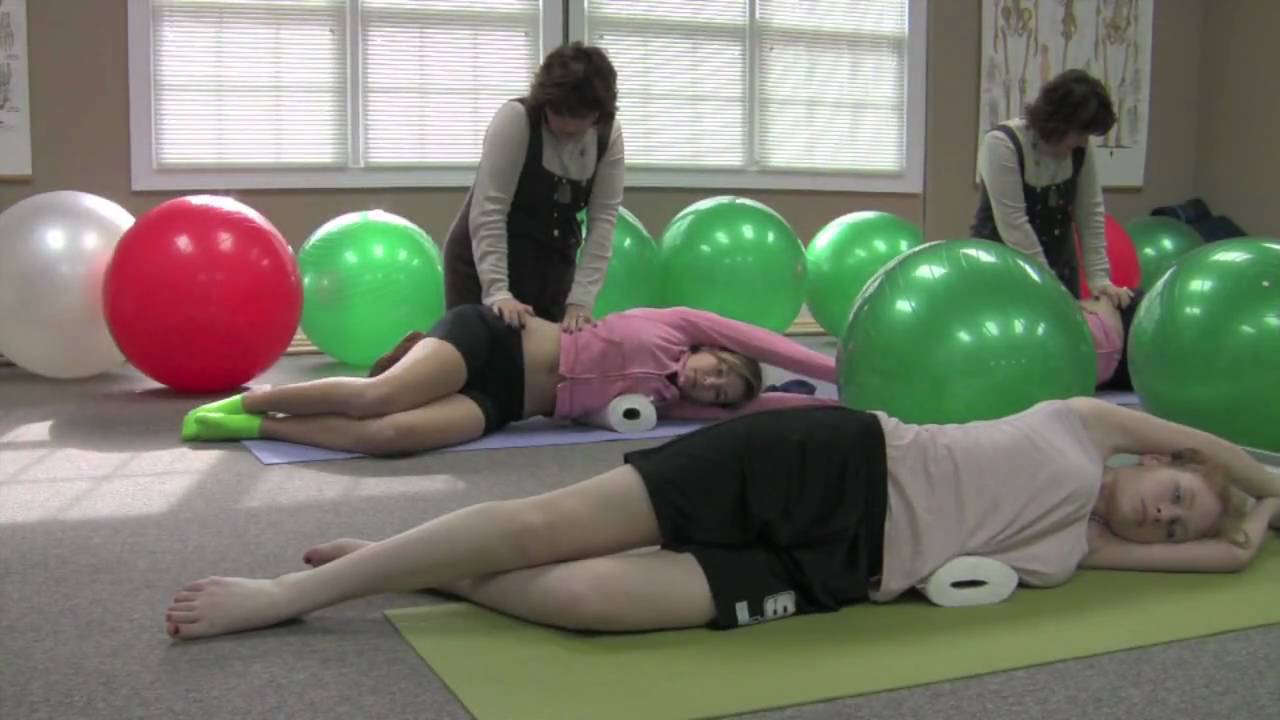 Acquire a foam roller, preferred to being warped with a towel. Lay the foam roller on an exercise mat, width-wise.
Acquire a foam roller, preferred to being warped with a towel. Lay the foam roller on an exercise mat, width-wise.- Next, lie across the foam roller one side of your body, and the foam roller should rest between the bottom of rib cage and hip.
- With your top leg straight and your bottom leg bent at the knee, stretch you upper arm outward until your hand reaches the floor.
- Hold this position for around 20 to 30 seconds, and carry out 2 to 3 reps daily.
3. Forward Bend with Exercise Ball
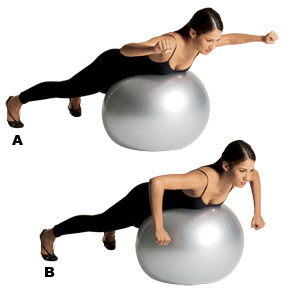 Kneel on an exercise mat and rest your stomach against the exercise ball and gently relax yourself and bend forward over the ball.
Kneel on an exercise mat and rest your stomach against the exercise ball and gently relax yourself and bend forward over the ball.- Next, try to relax your body and make your back vertically above the ball.
- Also, reach out your legs and arms straightlyso that your whole body is vertically to the exercise ball.
- Balance your body and hold it for about 10 seconds, carrying out ten repetitions.
4. Bent-Over Weighted Stretches
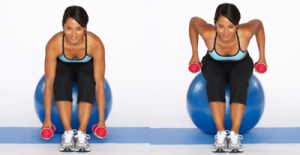 Sit on a large exercise ball, keeping your feet in front of you, flat on the floor to gain balance.Bend forward so your body assumes a shape similar to a table.
Sit on a large exercise ball, keeping your feet in front of you, flat on the floor to gain balance.Bend forward so your body assumes a shape similar to a table.- Pick up the light weights within your hands and raise them until they are parallel with the floor, ensuring to keep the arms close to your sides and your elbows soft, and then lower the light weights down and repeat the motion.
- Do 10 reps of this exercise, and 3 sets.
5. Raised Knee Spine Release
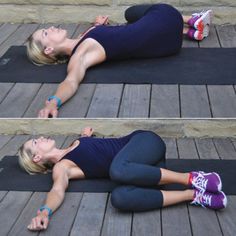 Lie on your back on the floor or a bed.Raise your knees upwards, forming a "T" shape.
Lie on your back on the floor or a bed.Raise your knees upwards, forming a "T" shape.- Next, move your knees in either direction, whilst ensuring to keep your shoulders flat on the floor.
- Lower you knees to a comfortable position before returning to the starting position.
- As mentioned, exercises for scoliosis can be very helpful, but also very dangerous, be sure to attain your doctors advice before trying any of these exercises.
6. Plank Partner Stretch
- First, start with the plank position to support your weight with elbows, forearms and toes.
- Then make your partner kneel on the convex side of your spine, and place his hands on your midriff.
- Next, let your partner help you achieve a deep stretch by pulling the midriff part towards him. Hold this stretch for 20 to 30 seconds, doing 3 to 4 reps for each day.
7. One Arm Reach and Step Down
- Step onto a box or step with whatever leg appears longest when lying on your back.
- Lower your other leg toward the floor whilst bending the knee of your supporting leg.
- As you make your decent, raise the arm on the same side of your lowered leg up as high as possible.
- Continue to do two or three sets of five to ten reps. But remember to not repeat the exercise on the opposite side.
8. Prone Plank Hip Stretch
- Assume a prone plank position with your arms stretched straight out.
- Push your hips back as far as you can without feeling discomfort, and hold for two seconds.
- Next, lower your hips back towards the floor, going as low as you can without experiencing pain.
- Carry out two to three sets of five to ten reps.
9. Stance with Leg Split and Arm Reach
- Identify which one leg appears longer then stride forward the longer leg, whilst keeping your torso upright and straight.
- Start to shift your weight forward and backwards, bending your forwarded knee as weight is placed upon it.
- As you shift your body weight forward, raise your arm on the opposite side as high as you can.Whilst reaching upward with one arm, reach your other arm backwards with your palm facing up. That is, if you forward your left leg then raise your right arm up and reach the left arm backwards meanwhile.
- Perform around two to three sets of 5 to10 reps, and do not repeat on the other side.
